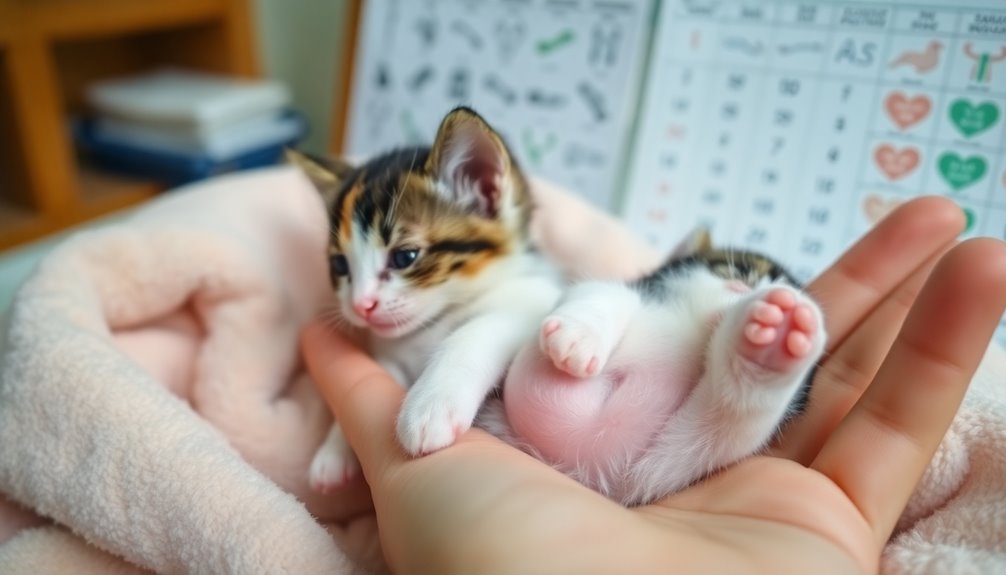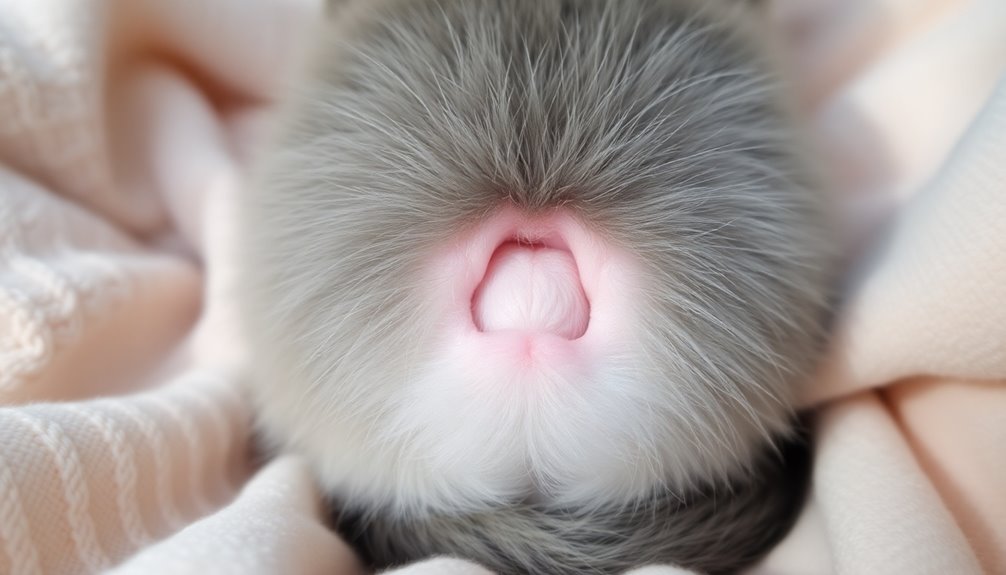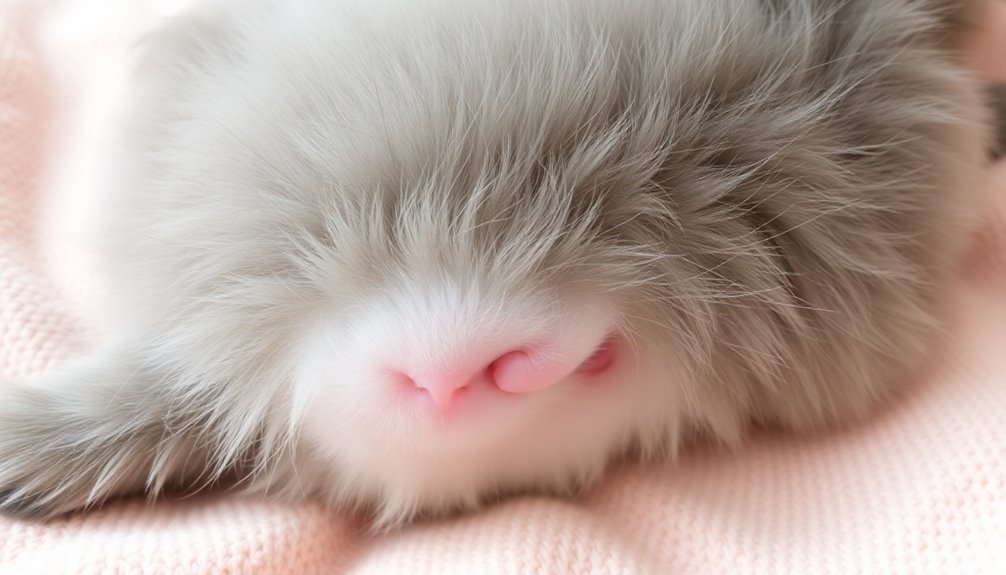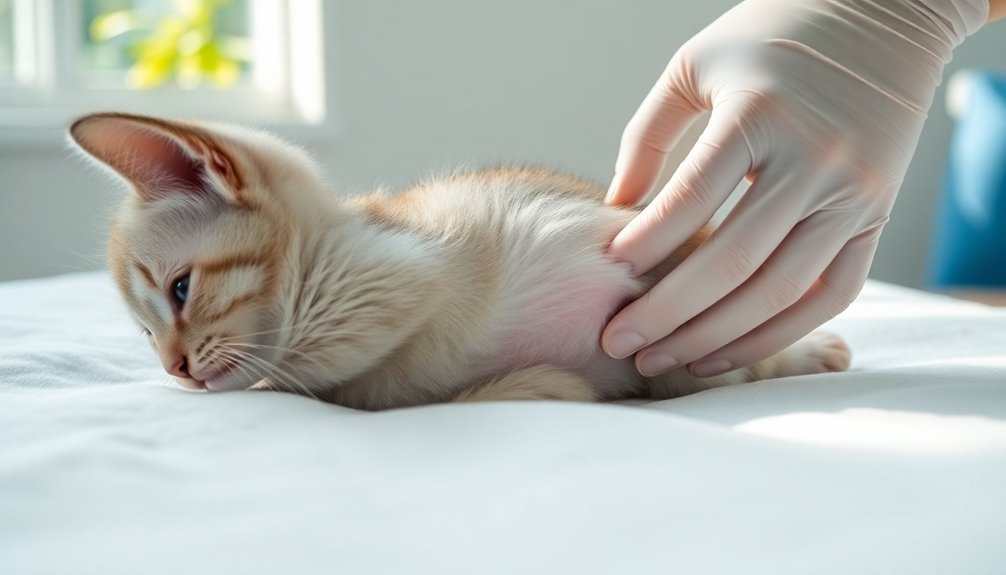To sex a kitten, gently lift its tail and check the genital area. Male kittens have a round-shaped opening about half an inch from the anus, while females have a vertical slit that's closer. You can better distinguish them as the kittens grow, typically around 8 weeks when their anatomy becomes more developed. Look for other indicators, like coat color; tortoiseshell cats are usually female. Familiarizing yourself with these traits can improve your accuracy. To enhance your understanding and guarantee proper care, there's plenty more useful information available on this topic.
Key Takeaways
- Gently lift the tail; male kittens have a round-shaped genital opening, while females have a vertical slit closer to the anus.
- Observe the distance between the anus and the genital opening; males have about 1/2 inch spacing, which is greater than in females.
- Male testicles usually become visible between 6 to 10 weeks, aiding in identification during this age range.
- Familiarize yourself with common coat color patterns; tortoiseshell/calico cats are mostly female, while orange tabbies are predominantly male.
- Consult a veterinarian for accurate sex confirmation and tailored health management advice, especially regarding spaying/neutering.
Anatomy of Kittens
Understanding the anatomy of kittens is essential for accurately determining their sex. When you examine the genital area, pay attention to the genital shape: male kittens have a round-shaped opening, while female kittens' genitals appear as a vertical slit.
You'll also notice a greater distance between the anus and the genital opening in males compared to females. As male kittens mature, their testicles will become visible, typically between 6 to 10 weeks of age.
Additionally, observe the fur around the genital area; male kittens tend to have more excess fur and tissue between the anus and the penis than female kittens, who've less fur.
This anatomical knowledge is vital for proper identification.
Visual Identification Techniques

Identifying a kitten's sex can be straightforward if you know what to look for.
Start by gently lifting the tail to examine the genital area. The first opening you'll see is the anus, followed by the genital opening.
In male kittens, this opening is round, resembling a colon (:), and is spaced about 1/2 inch from the anus.
Female kittens, on the other hand, have a vertical slit that looks like an upside-down exclamation point (¡) and is closer to the anus.
As male kittens grow, their testicles may become visible by 6 to 10 weeks, providing further confirmation.
Observing multiple kittens can enhance your visual identification skills, making it easier to distinguish sex based on these characteristics.
Age Considerations for Sexing
When it comes to sexing kittens, age plays a significant role in your success. Kittens typically reach an age suitable for sex determination around 8 weeks, when their physical traits become more pronounced.
Before this, identifying the sex of your kitten can be tricky, as genitalia aren't fully developed in the first four weeks. Male kittens start showing testicles under the skin between 6 to 10 weeks, making it easier to determine if they're male or female.
Additionally, the distance between the anus and the genital opening becomes more apparent as they grow, further aiding identification. Regular observation and handling from an early age can help you improve your skills in determining the sex of your kitten as it matures.
Veterinary Guidance Importance

Although you might feel confident in your ability to sex a kitten, consulting a veterinarian is vital for guaranteeing accuracy, especially if you're inexperienced. A vet can help you determine the sex of your kitten more effectively and provide essential veterinary care.
Here are some reasons to seek their guidance:
- Expertise: Vets can accurately confirm if your kitten is male through a thorough examination.
- Best Practices: They offer tips on safe and efficient sexing methods.
- Health Monitoring: Regular check-ups guarantee your kitten's overall health is on track.
- Behavioral Insights: Understanding the sex can aid in managing behavior and planning for spaying or neutering.
Don't hesitate to reach out; it's an important step in responsible pet ownership!
General Observations on Sexing

When you're sexing a kitten, pay close attention to the anatomical differences; male kittens have a circular opening while females sport a vertical slit.
You'll also notice a greater distance between the anus and genital opening in males, which can help with identification.
Additionally, coat color can offer clues, as patterns like tortoiseshell and calico are mostly female, while orange tabbies lean male.
Anatomical Differences Explained
Understanding the anatomical differences between male and female kittens is essential for accurate sexing. Here are some key observations:
- Distance: Male kittens have about a 1/2 inch gap between the anus and genital opening, while females have theirs positioned closer.
- Shape: Male genitalia appears circular, resembling a colon, whereas female genitalia looks like a vertical slit or teardrop.
- Excess Skin: Males often show more skin and fur between the anus and genitalia, which is less pronounced in females.
- Testicles: By 6 weeks, you can feel developing testicles in male kittens, while females won't exhibit this feature.
Recognizing these differences will help you accurately determine the sex of your kitten, ensuring proper care and management.
Color Patterns and Sex
Many cat enthusiasts find that color patterns can offer clues about a kitten's sex, but it's essential not to rely solely on this method.
For instance, calico and tortoiseshell kittens are mainly female cats, with male torties being extremely rare. On the flip side, around 90% of orange tabby kittens are male cats, making this a somewhat useful indicator.
When you encounter tricolor cats, the likelihood of finding a female increases, with about 1 in 3,000 being male due to genetic anomalies.
Remember, while color patterns can provide hints, always combine this observation with a physical examination for a more accurate determination.
Variability in coat color means this method isn't foolproof, so practical observation remains key.
Identifying Female Kittens

When you're trying to identify female kittens, pay close attention to their genital appearance.
You'll notice a vertical slit or teardrop shape that's positioned closely to the anus, making it easier to distinguish from males.
Additionally, if you spot a tortoiseshell or calico coat, it's likely you've found a female, as these patterns are mainly female in kittens.
Genital Appearance Comparison
Identifying female kittens can be straightforward if you know what to look for in their genital appearance. Here are some key characteristics to help you determine the sex of a kitten:
- Shape: Female kittens have a genital opening that resembles a vertical slit or teardrop shape.
- Distance: The distance between the anus and the vaginal opening is shorter in females compared to males.
- Fur: You'll notice less excess fur and tissue around the genital area of female kittens.
- Visual Cue: The genital area of a female kitten looks like an upside-down exclamation point (¡).
Coat Color Indicators
After examining the genital appearance, coat color can also offer hints about a kitten's sex.
For instance, if you see calico or tortoiseshell patterns, it's highly likely you're looking at a female, as about 99.9% of these kittens are girls.
On the other hand, if you encounter an orange or ginger kitten, there's a 90% chance it's male, with only 10% of orange tabbies being female.
Remember, male tortoiseshells are incredibly rare, occurring in roughly 1 in 3,000 cases.
While coat color does provide some clues about a kitten's gender, it shouldn't be your sole method for determining kittens' sex, as exceptions do exist.
Always combine this with other identification techniques for accuracy.
Identifying Male Kittens

To determine if a kitten is male, you'll want to closely examine its genital region. Here are some key indicators:
- Anogenital Distance: Male kittens have a genital opening that appears circular and is spaced about 1/2 inch from the anus, indicating greater distance than females.
- Shape: The male genitalia resembles a colon (:) shape, while females display a straight line or teardrop shape.
- Excess Fur and Tissue: You'll notice more excess fur and tissue between the anus and the penis in males.
- Testicle Visibility: As male kittens grow, testicles may become visible between 6 to 10 weeks of age.
Health Considerations for Kittens

Understanding health considerations for kittens is essential, as their well-being can greatly impact their development and quality of life.
Early spaying/neutering is important, especially for male kittens, who face a higher risk of urinary tract issues. For female kittens, spaying before their first heat can prevent serious conditions like pyometra, a life-threatening uterine infection.
Regular veterinary check-ups are fundamental for both sexes to monitor growth and catch health issues early. Knowing your kitten's sex helps tailor health management, as behaviors and risks differ.
Since kittens reach sexual maturity around 5-6 months, early spaying/neutering can positively influence their growth and behavior, ensuring they develop into healthy, well-adjusted pets.
Additional Resources for Pet Owners
How can you guarantee you're well-equipped to care for your kitten? Utilizing a variety of resources can help you feel confident in your care. Here are some valuable options:
- Online resources: Explore educational articles and videos that provide step-by-step instructions for identifying your kitten's sex.
- Veterinary consultations: Schedule a visit to get expert guidance and ascertain your kitten's overall health.
- The Kitten Lady: Check out their gallery and educational content to better understand kitten care and health assessment.
- Downloadable fact sheets: Use quick reference sheets on kitten sexing for easy identification and care tips.
Frequently Asked Questions
At What Age Can You Tell a Kitten's Gender?
You can generally tell a kitten's gender around 4 to 6 weeks of age.
At this stage, you'll start noticing identifiable characteristics.
By 6 to 8 weeks, male kittens may have developing testicles, making it easier to determine their sex.
As they grow, the physical differences become more pronounced, allowing you to assess their gender more accurately.
Observing these changes helps you understand their developmental milestones better as they mature.
How Can You Tell the Sex of a Newborn Kitten?
You might think it's easy to tell the sex of a newborn kitten, but it's actually quite tricky.
Until they're about three weeks old, you can't rely solely on their physical features. Instead, observe their urination habits—males create a stream, while females tend to spill.
After four to six weeks, you can visually inspect the genital area, where females' resemble an upside-down exclamation point.
Always handle them gently to keep them calm and healthy.
What Does a Female Kitten's Private Look Like?
When you look at a female kitten's private area, you'll notice it has a vertical slit or a teardrop shape, located close to the anus.
The distance between the two is shorter than in males. You might see less fur and tissue around this area.
If you gently lift the tail, you'll see that the genitalia resembles an upside-down exclamation point (¡), which can help you identify her more easily.
How to Tell if a Kitten Is 3 Weeks Old?
When you first spot a kitten, excitement builds as you try to determine its age.
At 3 weeks old, you'll notice its eyes are opening wide, revealing a curious gaze.
It's starting to wobble around, attempting to stand and walk.
Watch for playful interactions with its littermates and a newfound interest in solid food.
You might even catch it grooming itself, showcasing its growing motor skills.
These signs confirm it's indeed 3 weeks old.
Conclusion
In conclusion, successfully sexing your kitten can be a simple yet significant skill. By studying their anatomy and using visual identification techniques, you'll become a savvy sexer in no time. Remember, patience and practice pave the path to proficiency. Don't hesitate to seek veterinary wisdom when unsure; it's always wise to prioritize your pet's health and happiness. With a little love and learning, you'll be well on your way to nurturing a joyful feline family!










